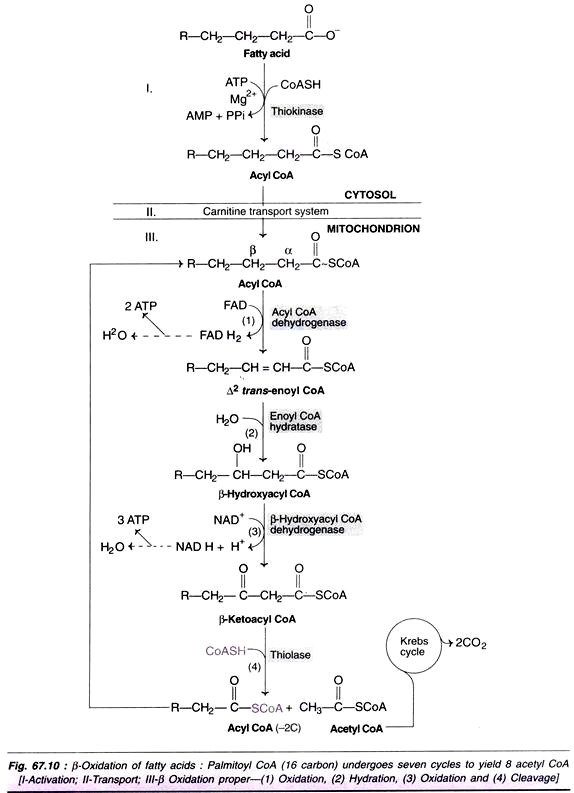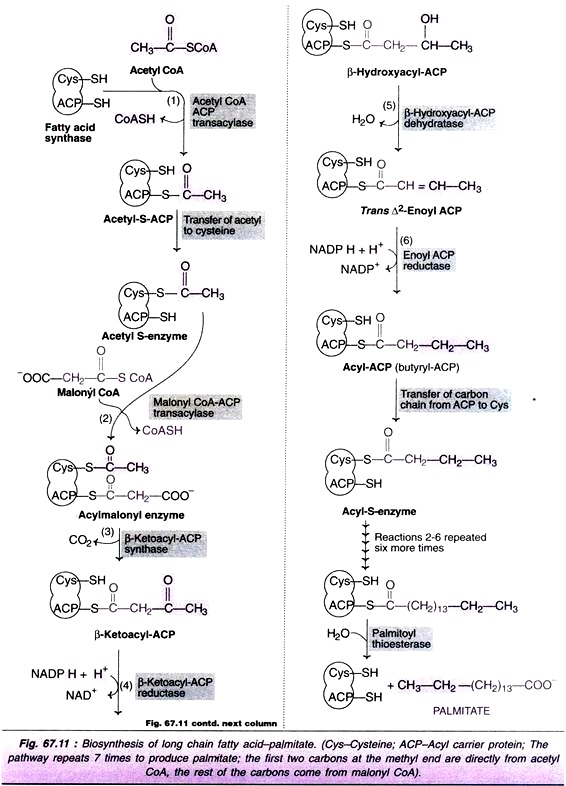This article throws light upon the five major pathways/cycles of lipid metabolism.
The five pathways/cycles of lipid metabolism are: (1) Fatty Acid Oxidation (2) Biosynthesis of Fatty Acids (3) Metabolism of Cholesterol (4) Cholesterol Biosynthesis and (5) Degradation of Cholesterol.
Lipids are indispensable for cell structure and function. Due to their hydrophobic and non-polar nature, lipids differ from rest of the body compounds and are unique in their action.
The important pathways/cycles of lipid metabolism are briefly described:
Cycle # 1. Fatty Acid Oxidation:
The fatty acids in the body are mostly oxidized by p-oxidation. β-Oxidation may be defined as the oxidation of fatty acids on the p-carbon atom. This results in the sequential removal of a two carbon fragment, acetyl CoA (Fig. 67.10).
Fatty acid oxidation— stages and tissues:
The β-oxidation of fatty acids involves three stages
I. Activation of fatty acids occurring in the cytosol;
II. Transport of fatty acids into mitochondria;
III. P-Oxidation proper in the mitochondrial matrix.
Fatty acids are oxidized by most of the tissues in the body. However, brain, erythrocytes and adrenal medulla cannot utilize fatty acids for energy requirement.
Cycle # 2. Biosynthesis of Fatty Acids:
The dietary carbohydrates and amino acids, when consumed in excess, can be converted to fatty acids and stored as triacylglycerol’s. De novo (new) synthesis of fatty acids occurs predominantly in liver, kidney, adipose tissue and lactating mammary glands.
The enzyme machinery for fatty acid production is located in the cytosomal fraction of the cell. Acetyl CoA is the source of carbon atoms while NADPH provides the reducing equivalents and ATP supplies energy for fatty acid formation.
The fatty acid synthesis may be learnt in 2 stages:
I. Conversion of acetyl CoA to malonyl CoA.
II. Reactions of fatty acid synthase complex.
I. Formation of malonyl CoA:
Acetyl CoA is carboxylated to malonyl CoA by the enzyme acetyl CoA carboxylase. This is an ATP-dependent reaction and requires biotin for CO2 fixation. Acetyl CoA carboxylase is a regulatory enzyme in fatty acid synthesis.
II. Reactions of fatty acid synthase complex:
The remaining reactions of fatty acid synthesis are catalysed by a multifunctional enzyme known as fatty acid synthase (FAS) complex. In eukaryotic cells, including man, the fatty acid synthase exists as a dimer with two identical units. Each monomer possesses the activities of seven different enzymes and an acyl carrier protein (ACP) bound to 4′-phosphopantetheine.
Fatty acid synthase functions as a single unit catalysing all the seven reactions. Dissociation of the synthase complex results in loss of the enzyme activities. The sequence of reactions for the extra— mitochondrial synthesis of fatty acids (palmitate) is depicted in Fig. 67.11, and described below
1. The two carbon fragment of acetyl CoA is transferred to ACP of fatty acid synthase, catalysed by the enzyme, acetyl CoA-ACP transacylase. The acetyl unit is then transferred from ACP to cysteine residue of the enzyme. Thus ACP site falls vacant.
2. The enzyme malonyl CoA-ACP transacylase transfers malonate from malonyl CoA to bind to ACP.
3. The acetyl unit attached to cysteine is transferred to malonyl group (bound to ACP). The malonyl moiety loses CO2 which was added by acetyl CoA carboxylase. Thus, CO2 is never incorporated into fatty acid carbon chain.
4. β-Ketoacyl ACP reductase reduces ketoacyl group to hydroxyacyl group. The reducing equivalents are supplied by NADPH (from HMP shunt).
5. β-Hydroxyacyl ACP undergoes dehydration. A molecule of water is eliminated and a double bond is introduced between α and β carbons.
6. A second NADPH-dependent reduction, catalysed by enoyl-ACP reductase occurs to produce acyl-ACP. The four-carbon unit attached to ACP is butyryl group.
The carbon chain attached to ACP is transferred to cysteine residue and the reactions 2-6 are repeated 6 more times. Each time, the fatty acid chain is lengthened by a two-carbon unit (obtained from malonyl CoA). At the end of 7 cycles, the fatty acid synthesis is complete and a 16-carbon fully saturated fatty acid—namely palmitate—bound to ACP is produced.
7. The enzyme palmitoyl thioesterase separates palmitate from fatty acid synthase. This completes the synthesis of palmitate.
Cycle # 3. Metabolism of Cholesterol:
Cholesterol is found exclusively in animals; hence it is often called as animal sterol. The total body content of cholesterol in an adult man weighing 70 kg is about 140 g i.e., around 2 g/kg body weight. Cholesterol is amphipathic in nature, since it possesses both hydrophilic and hydrophobic regions in the structure.
Cycle # 4. Cholesterol Biosynthesis:
About 1 g of cholesterol is synthesized per day in adults. Almost all the tissues of the body participate in cholesterol biosynthesis. The largest contribution is made by liver (50%), intestine (15%), skin, adrenal cortex, reproductive tissue etc.
The enzymes involved in cholesterol synthesis are found in the cytosol and microsomal fractions of the cell. Acetate of acetyl CoA provides all the carbon atoms in cholesterol. The reducing equivalents are supplied by NADPH while ATP provides energy. The key intermediates of cholesterol formation are depicted in Fig. 67.12.
Cycle # 5. Degradation of Cholesterol:
The steroid nucleus (ring structure) of the cholesterol cannot be degraded to CO2 and H2O. Cholesterol (50%) is converted to bile acids, excreted in feces, serves as a precursor for the synthesis of steroid hormones, vitamin D, coprostanol and cholestanol. The latter two are the fecal sterols, besides cholesterol.


